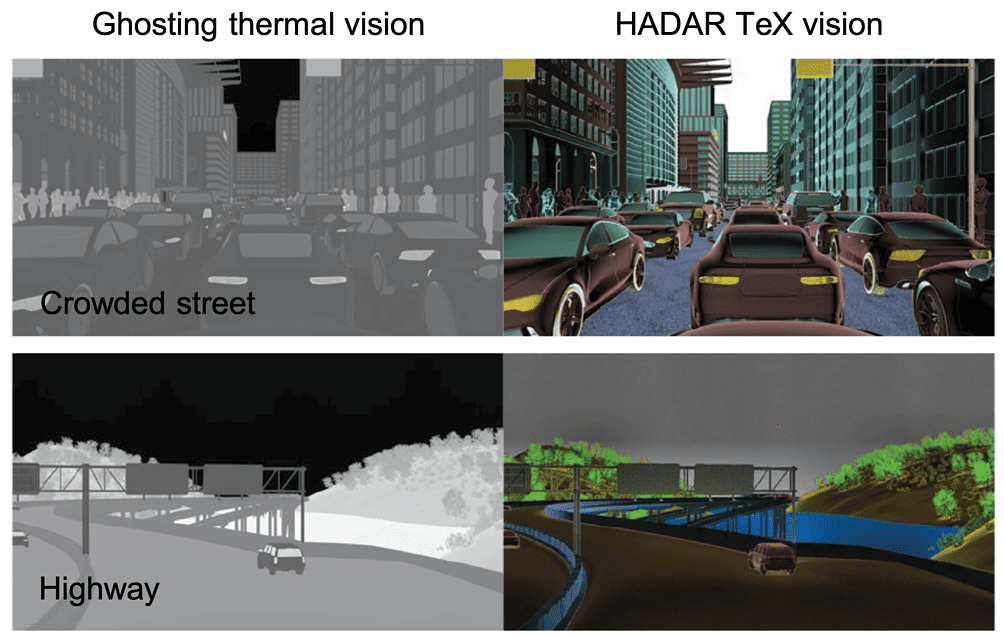
Researchers from Purdue University and Michigan State University have developed HADAR, a ground-breaking camera imaging system. Their research was published in Nature. Through the application of artificial intelligence, HADAR interprets heat signatures, providing unprecedented clarity in thermal imaging. This technology is set to revolutionise the way autonomous vehicles and robots perceive their surroundings, overcoming traditional ‘ghosting’ issues associated with heat radiation. HADAR successfully detects temperature, material composition, and thermal radiation patterns, even within visually obstructed environments. HADAR’s potential is vast, with future applications ranging from self-driving vehicles to touchless security screenings at public events.
- Researchers from Purdue University and Michigan State University have developed HADAR, a ground-breaking AI-enhanced camera imaging system.
- HADAR overcomes the ‘ghosting’ effect associated with traditional thermal imaging.
- The potential applications of HADAR are vast, ranging from improving the perception of self-driving vehicles and autonomous robots to touchless security screenings at public events.
Overcoming the ghosting effect: AI-enhanced thermal imaging
HADAR, or ‘heat-assisted detection and ranging’, brings a new dimension to thermal imaging by successfully overcoming the ‘ghosting’ effect. Ghosting is a common issue in traditional thermal imaging, where the diffusion of thermal radiation particles creates blurry and textureless imagery. HADAR, through its innovative application of artificial intelligence, cuts through this optical clutter and provides detailed and sharp images, regardless of visual obstructions.

The researchers at Purdue University and Michigan State University have utilised machine learning algorithms to tackle the ghosting problem. Their AI model is trained to discern the physical properties of objects and their surroundings from the information gathered by commercial infrared cameras. This innovative approach has allowed HADAR to reconstruct night-time scenes with a clarity akin to daytime imagery.
Hadar’s potential: From autonomous vehicles to public security
HADAR’s potential applications are vast and varied. Its superior imaging capabilities could become integral to artificial intelligence systems within self-driving vehicles, providing these autonomous vehicles with an enhanced perception of the world around them. The researchers believe that HADAR’s technology could also be incorporated into autonomous robots, enabling these machines to navigate more efficiently and effectively.
HADAR’s potential isn’t limited to robotics and autonomous vehicles. Its ability to detect temperature, material composition, and thermal radiation patterns lends itself to a variety of other applications. For instance, HADAR’s thermal imaging could be utilised for touchless security screenings at public events, providing a more detailed and efficient means of screening large crowds.
Challenges and future prospects
Despite its promising capabilities, HADAR faces several challenges that need to be addressed before it can be widely adopted. The current cost of the equipment, real-time calibration requirements, and susceptibility to environmental barriers are significant hurdles. However, the researchers are confident that these challenges can be overcome, allowing HADAR to reach its full potential.
Furthermore, HADAR’s applications extend beyond practical uses. Its creators have found personal benefits from the technology, such as overcoming the fear of the dark. The ability to provide vibrant information during the night, similar to daytime, has helped the creators feel more comfortable in low-light conditions.
The Future of Night Vision
The development of HADAR has the potential to transform the night vision capabilities of autonomous vehicles and robots. It surpasses traditional thermal imaging by utilising machine learning to accurately identify objects based on heat signals. HADAR’s ability to provide detailed and clear images regardless of visual obstructions could revolutionise the way autonomous systems perceive their environment.
While challenges remain, the scalability and passive nature of HADAR inspire future advancements in imaging and vision technologies. The development of HADAR technology offers significant potential for improving night-time computer vision and autonomous vehicle performance.







